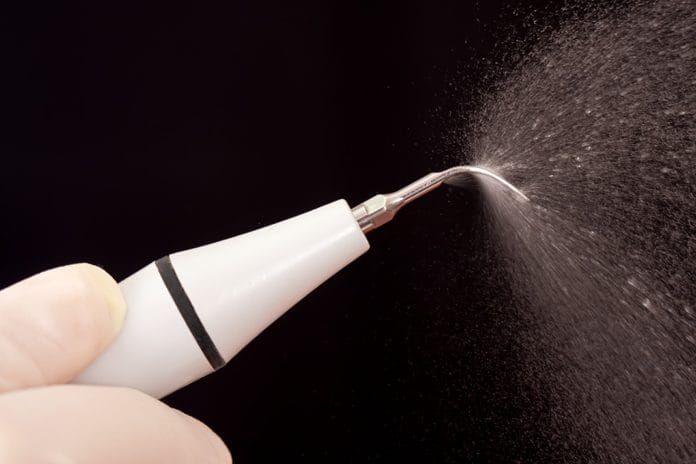Ultrasonic scaling has been around for decades and should be part of the dental hygienist’s daily patient routine. Sonic scalers are still around, but most have transitioned to ultrasonic scalers.
Ultrasonic Scaling Technology
There are two types of ultrasonic scalers: magnetostrictive and piezoelectric. Both ultrasonics are effective but operate differently. Piezoelectric devices use electrical energy to activate crystals within the handpiece to vibrate to the instrument tip.1 Magnetostric devices transfer electrical energy to metal stacks made of nickel-iron alloy or to a ferrous rod to vibrate the insert.1
When using magnetostrictive technology, it is important to understand all sides of the tip are active. The lateral sides are most commonly used, but the face and back are also active. To compare, only the lateral sides of piezoelectric technology are active. When using both technologies, it is very technique sensitive, and understanding which sides to use is a biggie! There can also be a learning curve when using one technology and then switching to the other. Rule of thumb, the direct tip should never be applied to the tooth as this can damage the tooth. The tip can be used on large pieces of calculus using a tapping method. But remember, it should not be placed directly on the tooth surface!
The goal of ultrasonic scaling is to effectively remove subgingival and supragingival calculus, reach deeper into periodontal pockets, and access furcation areas. In addition, ultrasonic devices act as irrigation and can flush the pockets of toxins.
There is a big question regarding solely using ultrasonic technology rather than following up with hand-activated instruments. Research shows they can be equally as effective if the appropriate tips/inserts are used. It also shows results are achieved in a faster time frame. When it comes to ergonomics, pressure is not needed during power-drive instrumentation, so we are helping our bodies when using ultrasonic technology as well.3
What To Use
Determining what tip or insert to use all depends on your patient’s oral health. It is not a one-size fit all choice, so it is important you have options, to ensure you are providing the best care. A basic overview is thicker tips or inserts can be used on a higher power setting and removes moderate-heavy calculus. To compare, thinner tips and inserts are used for lighter calculus or biofilm disruption and should be used on a lower power setting. It is always important to read the manufacturer’s directions as correct usage can differ depending on what brand/manufacturer is being utilized.
So next question, must everyone have a thick tip/insert used on him or her? No! It all depends on what the patient’s oral health looks like when they present. The world of dental hygiene does not come with a formula. What works for one patient will not work for the next. It is important to remember this concept as we get into the groove of our days. We may need four tips for one patient and only two tips for the next patient.
Properly Using an Ultrasonic Scaler
The biggest misconception of ultrasonic use is needing lateral pressure in order to be effective. When pressure is applied during ultrasonic use, the tip will not vibrate. The vibrations of the tip activate and help remove or pulverize the calculus. The use of the ultrasonic will be very ineffective is pressure is applied.
When removing calculus, it is also very different from a hand instrument. Clinicians remove calculus apical to coronal with hand instruments. When using an ultrasonic, calculus should be removed coronal to apical.1
Periodontal Tips/Inserts
Are periodontal tips/inserts necessary to use? Yes! These tips are also known as right and left, and make such a difference when scaling a patient with pocket depths 4 mm or larger. They better adapt to the tooth to reach areas which are difficult with a straight tip. Periodontal tips are able to reach deeper pockets as well as areas with furcation involvement. Straight tips do not work that way in the posterior! And I get it, to switch an insert/tip means time lost during the appointment, but we have to put the patient’s oral health first and do what is best for them.
How to Adapt Right and Left Tips
Adapting right and left tips/inserts can be tricky. Depending on the technology being used, there are also differences. When using piezoelectric technology, right and left tips are used similar to a curette. It will look like a Naber’s probe is being inserted into the furcation. Again, to compare, it is opposite for magnetostrictive technique. When using right and left inserts, if it looks like a Naber’s probe, mostly like the wrong insert is being used for that part of the mouth. Of course, clinicians’ can memorize where the right insert is used and where the left insert is used in the mouth. However, it is important to understand what the insert looks like to be fully effective when using the technology.
To conclude, ultrasonics not only make our lives easier ergonomically, but ultrasonic usage is also extremely beneficial for the patient. Patients are not created equally, and we have to determine the need for each of them. A variety of ultrasonic tip/inserts is a must for achieving the best oral health outcome for our patients.
Infection Prevention
Aerosols are produced during dental treatment, such as when using the air and water syringe, ultrasonic scaling, air polishing, restorative work, crown preparation, and the list goes on and on. Based on what procedure we are doing the mask level will vary. There are currently three American Society of Testing Materials (ASTM) levels for masks. When using the ultrasonic or air polisher, the ASTM Level 3 mask should be worn due to moderate levels of aerosols.2 In addition, the use of a high-volume evacuation (HVE) suction should be used during ultrasonic scaling. This will help to reduce aerosols and keep us safer and healthier!
SEE ALSO: QUIZ: Test Your Ultrasonic Scaling Knowledge!
DON’T MISS: Smart Scaling for a Better Paitient Experience
Now Listen to the Today’s RDH Dental Hygiene Podcast Below:
References
- Gehrig, J. S., Sroda, R., & Saccuzzo, D. (2017). Fundamentals of periodontal instrumentation & advanced root instrumentation (8th ed.). Philadelphia: Wolters Kluwer.
- Molinari, John A, and Peri Nelson. “Face Masks: What to Wear and When.” Dental Advisor, Dental Consultants, 2014, dentaladvisor.com/pdf-download/?pdf_url=wp-content/uploads/2015/02/face-masks-what-to-wear-and-when.pdf.
- Taib, H., Cheng Mei, L., Khamis, M. F., & Arief, E. M. (2017). Evaluation of the effects of different scaling modalities on the root surfaces: an in vitro study. Journal Of Oral Health Research, 8(1), 5-11.












